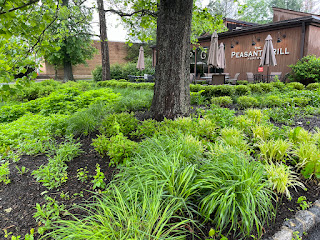Maintenance is looked down upon and taken for granted in our culture. One reason for this is that, done well, maintenance is invisible. Our human tendency is to notice what is wrong, not what is kept right. At home, we are more likely to notice dirt and disarray than the cleanliness and order a housemate worked hard to achieve.
In landscaping, the tendency is to fund and celebrate design and installation, then leave maintenance to the vicissitudes of chance, undertrained and undermotivated staff, and perennially strapped budgets. But even with the best designs, maintenance is what ultimately matters. Maintenance is destiny.
Maintenance at its best is a form of love. In gardening, what we call maintenance is really more akin to the nurturance of parenting--an ongoing process of encouraging what is desired, and discouraging what is not. A garden can also be thought of as a playground. When maintenance is done right, plants that exhibit bullying behavior, like mugwort, don't get to play in the garden.
Environmental groups encourage people to dig up some lawn and plant native wildflowers. These meadow plantings are characterized as low-maintenance, but that is true only if the weeds are caught early. Once the weeds get firmly established, maintenance becomes very difficult.
The only gardens I've seen flourish are those that are loved, like a child is loved. Love leads to knowledge and steady attention, and early intervention when things go wrong.
Just off Witherspoon Street in Princeton there are contrasting examples of loved and unloved public gardens.
The loved garden in this instance has almost no weeds--a standard few of us achieve. For years, near the entrance to the Community Pool, gardens around the Princeton Recreation Department offices were taken care of by "Vikki C. and Team PRD," as the sign proudly declares. That would be employee Vikki Caines.
Vikki's glorious plantings expanded over the years well beyond the Rec. Dept. building. She retired in 2023, but when I asked her, she assured me that her gardens would continue to be well kept.
By contrast, just down the street, past the Princeton First Aid and Rescue Squad, lies a rain garden that collects water from hard surfaces around the town's fuel storage tank. Regulations require that raingardens be dug and planted to collect and filter runoff from new paved areas. In a series of posts, I've tracked the destiny of this very public but largely unnoticed raingarden, whose
extended limbo in 2020 ended with
planting in 2021. But in gardening, as when a baby is born, the birth of a garden is not the end but rather just the beginning. In 2022, it was still full of color and
easy to weed, but by 2023
the weeds were getting entrenched.
I alerted town staff that the raingarden was losing out to the weeds, and was told that the municipality was weeding it once or twice a year, and was working "towards a system of regular maintenance, while balancing many, many other priorities."
This year, the original plantings are beginning to disappear beneath waves of mugwort, nutsedge, and other botanical bullies that don't play well with others--
weeds like foxtail grass,
and wild lettuce--to name just a few of the species that maintenance crews would need to be able to recognize and remove. Note that the designer of a garden must know only the intended plants, while the maintainer, typically underpaid and underappreciated, must additionally know and recognize the many weeds that can invade.
This is the difference between loved and unloved gardens. Imagine a child being notified that a parent was "working towards a system of regular visits, while balancing many, many other priorities."
Now, a town's public works department does of course have many other priorities. Job one is to serve people, not gardens. But that being the case, the aim would be to keep the raingarden in the easy-to-maintain stage by catching the weeds early. Vigilance and early intervention--a form of love--save time.
The only way Vikki Caines could maintain beautiful gardens while also doing her job in the recreation department was to stay on top of the weeding.
Well-designed raingardens are easier than most gardens to maintain. The runoff they collect keeps the soil soft for easy weeding, and many native species of wildflowers and shrubs are adapted to flourish in the wet ground. Regulations can call for the digging and planting of raingardens, but the fate of the planting is left to chance. Weeds grow 24/7, while people are easily distracted. If the weeds take over, the ultimate response will be to mow it down and manage it as lawn. Nature's complexity, unloved, unnurtured, will once again be simplified and suppressed, the better to pursue other priorities.
Related posts:



















































